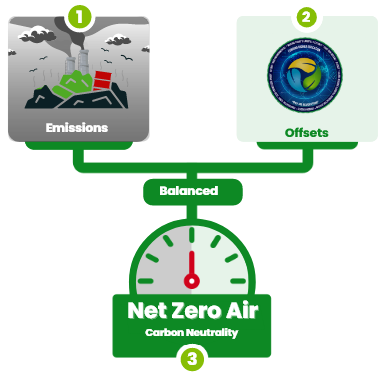

The more carbon dioxide we emit, the more damage our environment has to bear. While we can't eradicate CO2 altogether, experts have set the carbon budget that tells us the amount of carbon dioxide we can safely emit while still keeping global warming under control. Carbon levels have already gone out of control. The US emitted around 5,130 million metric tons of energy-related CO2 in 2019.
Our natural carbon sinks such as oceans and forests are not enough to control the situation. For this purpose, we need carbon offsetting, a phenomenon that allows communities and businesses to invest in innovative projects that reduce greenhouse gas (GHG) emissions. This is the only way to become carbon neutral.
Businesses have to calculate and reduce their carbon footprint. But, it can only go to a point. You will eventually have to try carbon offsetting where you will still be producing carbon dioxide but somewhere in the world, there will be action to offset them.
It can be done in two ways, by reducing carbon that’s already in the air or by preventing its emission. At NGD Environmental, we believe in preventing carbon emissions by using a unique and sustainable system.

What are carbon credits?
A carbon credit refers to the right to emit a set amount of greenhouse gas beyond what’s allowed. One carbon credit equals to one tonne of CO2. Governments have capped greenhouse gas emissions and businesses have to offset their emission by investing in carbon offsetting projects and buying carbon credits to be able to continue to operate.
Carbon credits are transferable and certified by independent or government bodies. The buyer of an offset credit can use it as an underlying reduction towards their own GHG reduction goals. Offset credits are used to deliver a net carbon benefit from one entity to another.
Greenhouse gas mixes globally in the atmosphere, meaning it's irrelevant where it's reduced. If you look at it from a climate change perspective, the effect is verbatim; it's as if an organization enabled an equivalent emission-reducing activity or ceased an emission-causing activity.
Carbon offset is an incredible tool that individuals and businesses worldwide can use to mitigate the impact of their carbon footprint.

How are carbon offsets generated?
Carbon offsets are generated by reducing carbon emissions. Traditionally, it was done by growing plants and investing in clean energy sources. However, these methods can be very slow, costly, and not always very efficient.
At NGD Environmental, we use a unique and sustainable method that involves landfills. Waste, trash, and garbage are traditionally filled in giant holes where they decompose and rot for years. This internationally accepted method results in the emission of harmful gasses.
We have created an Aerobic Landfill Bioreactor System (ALBS) to remedy the situation. This system prevents harmful gasses from leaking, thus generating carbon credits during the process that can be bought and sold.
Our system is recognized by the US EPA and the United Nations as CDM Methodology Number "AM0083". It’s a highly efficient way to run a landfill as our system makes landfills sustainable and reusable. NGD Environmental ALBS has no competing technologies.
The average landfill is 33 acres and holds around 1 million tons of garbage. It emits millions of tons of methane gas for years into the future. This is a major concern since methane gas is 25 times more toxic than CO2. ALBS can reduce this emission by up to 95%.
Gasses that our system reduces will turn into carbon credits in the future. You can invest in our landfills through our $NGDE tokens. Once available, these credits will be bought and sold as NFTs.
Calculate, Conserve and offset
The average American produces 16 tons* of CO2 per year. That's equivalent to filling your car with 1,633** gallons of gas.
1.

Calculate your carbon footprint
Use our calculators and calculate your carbon footprint
2.

Purchase Future Carbon Credits as Tokens
You can purchase the $NGDE based on your next 10 or 20 Year Carbon footprint
3.

Exchange Tokens for Carbon Credit
You can use $NGDE to purchase the CarbonCredits as NFT
Frequently Asked Questions
What is emissions trading and how does it work?
Emissions trading, also known as 'cap and trade', is a market-based approach to address climate change.
The 'Cap'
The basic principle involves setting a limit on the total quantity of GHG emissions allowed to be released over a given period of time (the “cap”). Each participant in the scheme receives an individual cap or allowance. Emission permits or allowances are issued to help cover these caps.
The 'Trade'
The trading part establishes a market for these permits by allowing organisations to buy and sell depending on whether they have a shortfall or surplus in allowances. (E.g. a participant who emits less than their allowance can sell the unused balance to another participant who has exceeded their allowance). Emissions trading encourages companies to continually reduce emissions - the more permits they don't use, the more money they can make from selling that excess.
Offsetting
Most emissions trading schemes also allow participants to purchase carbon credits from GHG emission reduction projects in developing countries. One credit equals one tonne of emissions saved. As long as these credits are certified to the correct level then they can count towards the emitter's target back home. However, to ensure that emitters are making a significant contribution to controlling their own emissions, and are not just buying their way out of their obligations, offset usage in trading schemes is usually limited to a proportion of the overall emissions target.
Is avoiding emissions better than fixation or sequestration of CO2?
It is correct that investments in climate forests do not contribute to reducing society's dependence on fossil fuels. But as long as fossil fuels are burned, forests are currently the only viable and scalable answer to re-capture carbon or CO2 from our atmosphere. In fact, the Paris Agreement underscores the urgent need for carbon sinks like forests to meet the ambition to limit global temperature rise to 'well below 2°C.'
Are carbon credits just 'permissions to pollute'?
No. Carbon credits are an investment in emission reductions to drive the transition to a low-carbon economy. Even with clean energy gaining momentum, there is a tremendous gap to fill to meet the 'well below 2oC' target the Paris Agreement sets for limiting global temperature rise. Companies that set 'Science Based Targets,'' that is, internal emission reduction targets in line with what science tells us to limit warming to 2C' and then go beyond by supporting projects that reduce global emissions are demonstrating best practice corporate climate action.






